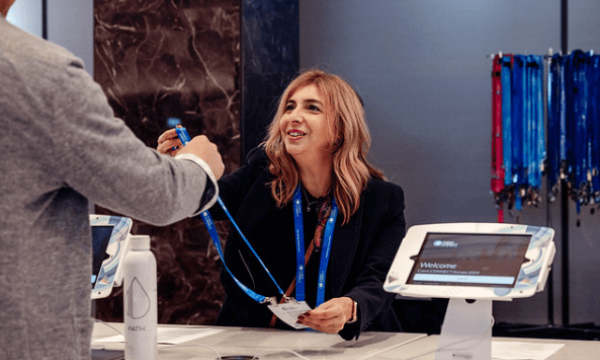With in-person events resuming and daily Covid cases continuing to fall across the US, events professionals and venues are finding themselves caught between the desire to return to face-to-face interaction and engagement and the uncertainty caused by new variants of Omicron and a corporate reluctance for business travel.
Staging events in 2022 and beyond will not be the same as planning in 2019, nor should it be. The world has irreversibly changed, and the accelerated digitization of the meetings and events industry provides a wealth of options to keep attendees safe, while still providing a fantastic hybrid or physical event experience.
A more conservative approach to maximizing budgets will require event departments to double-down on planning and understanding conference, meetings, and event audiences.
Venue partnerships require flexibility and increased communication on how both in-person and online attendees will journey through each stage of the event, consumer content, and network with one another.
Find the Right Venue for your In-Person Event
Forget what you knew about space requirements. Even as guidelines change, clients will feel more confident with social distancing measures in-place. Therefore, as you search for the perfect backdrop to host your next event, look for venues that provide flexibility, virtual site tours and greater reassurance that comfort and safety needs can be met.
With venue sourcing technology, you have a powerful database at your fingertips that will allow you to:
- View destinations and venues at your fingertips
- Narrow down your choices and filter results in seconds
- Send Request for Proposals (eRFP) directly from the system
- Evaluate your eRFP responses more efficiently
- Go on virtual venue tours with real-time collaboration
- Store all your historical bids and contracted rates in a single system of record.
Collect Essential Attendee Information
By surveying employees or past attendees, develop an understanding of how many are likely to attend in-person and what the appetite is for an online version for those not able or willing to travel.
Communicating early enough in the planning process will also allow you to establish what types of safety protocols in-person delegates would feel most comfortable with.
Will you need additional break-out rooms to split people into smaller or more spaced-out groups? Will you need to reassess food and beverage delivery based on changing guidance or group preferences?
By establishing attendee comfort and safety needs earlier, you’ll give yourself more time to plan with your venue and technology partners - thus reassuring registrants that attending in-person will result in a positive, safe experience.
Then, use event registration as a tool to further screen attendees and add a health check to your event.
Delegates can be approved for event entry, only if they meet the specific vaccination, testing, and general health status criteria you’ve set in advance. They’ll then be able to visually display their pass onsite to gain entry.
Ask registration questions that allow you to:
- Identify attendee travel locations
- Keep a record of location data for contact tracing
- Utilize attendee tracking with RFID badges to manage sensitive areas for staff, VIPs, or high-risk attendees.
- Ensure that everyone inside the event space is vaccinated and Covid safe.
Design Room Layouts that Embrace Social Distancing
Use event diagramming tools to create room layouts that comply with social distancing guidelines. Create seating arrangements that put more space between attendees.
Rather than building room layouts with traditional tightly packed rows, stagger seats.
With the right tools, you can easily design your event to accommodate social distancing and safety guidelines to ensure you have the right attendee capacities for each space.
Diagramming tools also allow you to map out where you’ll place hand sanitizing stations, mask stations, wall-mounted cleanliness stations, and more throughout public areas.
Offer Touch-less Event Check-In & Badge Printing
Avoid contact between attendees and staff during check-in.
With the use of a QR code or digital wallet information, received before the event, attendees can check-in and print their badge without touching any screens. This way, you can minimize contact and keep attendees and staff healthy.
Manage Room and Session Capacity
Controlling session attendance is one of the primary methods you can use to manage safe distancing for attendees to comply with guidelines. Set strict session capacities to ensure that only the safest number of attendees will be allowed to register for each session.
Then, have planners check attendance to poplar sessions early, so they can make session adjustments if needed.
Use self-check-in kiosks to facilitate contactless check-in for attendees. Check how many attendees are registered for each session and create the layout for the room based on occupancy numbers, considering social distancing guidelines.
During the event, use scanners when checking-in attendees to manage capacity controls. Planners can also use event management tools to monitor attendance closely and use overflow session rooms for near or at capacity sessions.
Quickly and Easily Communicate with Attendees
A mobile event app is an excellent tool for communicating with attendees quickly and efficiently before, during, and post-event. Attendees can use an event mobile app to receive all relevant information, communication, notifications, and content.
Push notifications can be used to manage overflow rooms for popular sessions and keep attendees informed, plus a dynamic event guide delivers updated alerts related to crises or health concerns.
When it comes to networking, a mobile event app facilitates connections between attendees while allowing them to maintain a distance through contact information sharing. Attendees are also able to express interest in exhibitors and sponsors before arriving at the event and set-up meetings.
A mobile app also helps provide the online attendees with the same audience interaction functionality as the in-room attendees. By ensuring that all polls and speaker questions are submitted through the app, it removes any chance of audience bias and creates a joined-up experience for hybrid events.
Add More Hybrid Elements
Hybrid events are truly a mix of what best fits your attendee’s needs so analyze your audience feedback and plan for delivering on what would improve their experience.
For example, you may decide to communicate event content via a webinar and then bring your audience together for a dinner later that same week to discuss the learnings and encourage them to network with their peers.
Alternatively, the demand may be for additional content beyond the physical event. In this case, a library of on-demand sessions filmed during the physical event could complement a year-round program of webinars and virtual talks.
Adding online elements to in-person event design will increase the accessibility, sustainability and reach of your event. It will help you to build community, grow advocacy and even give you opportunities to increase revenue through online sponsors and commercial add-ons.
An unquestionable benefit of hybrid attendance is you can see exactly how online attendees behave. You can gather data on how they interact with your content, which sessions they do - and don’t - attend, and you can use audience engagement tools to find out about their challenges, goals, and even purchasing requirements.
If your event has sponsors, be prepared for those sponsors to still want thorough data points from in-person attendees as well as online.
Safely Facilitate Onsite Meetings Between Attendees
Appointments are a staple at any event. To manage capacity and the timing of attendee interactions, consider using pre-scheduled appointments.
Allow attendees or planners to schedule meetings before or during the event to maximize face-to-face interactions. Attendees don’t have to be onsite, either. Virtual attendees can also book appointments. By using a virtual diagramming tool, planners can adjust meeting room layouts to comply with social distancing guidelines.
Enable Touchless Contact Sharing
Give attendees and sponsors the tools to network safely. With the right lead capture tools, attendees or sponsors can collect contact information with a single scan or wave of an RFID encode badge.
This will allow attendees to keep their distance. Sponsors and trade show booth participants love to distribute content to attendees, but rather than give physical one-sheets, send, and receive event content and literature to decrease contact and save paper.
Stay informed and Ready to Adapt
The best thing meeting and event planners can do is educate themselves and be flexible. Embrace adaptability and rely on event technology to make your meetings and events better than ever.
You can leverage the insights from attendee data to help make improvements to both the content and the design of future events. Event planners have never had so much data to work with and now it’s time to put it to use to ensure your future programs are driving Return on Investment in safe and successful event environments.
Watch the webinar to learn more about Best Practices for the Return of Safer In-Person Events.





